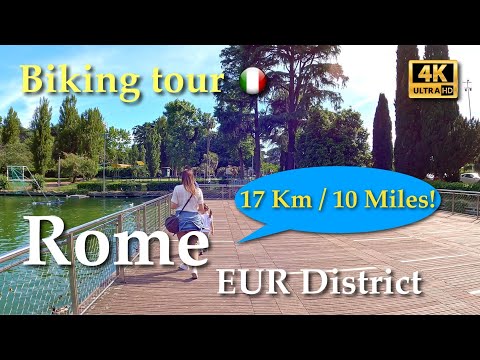Rome | EUR District, Italy【Biking Tour】With Captions - 4K

[Brief intro] 1/7 Brief History of EUR☀️ In 1935 the governor of Rome, Bottai, proposed to Mussolini to nominate the capital for the future universal exhibition of 1942, which would have made it possible to celebrate the 20th anniversary of the march on Rome and propose the success of fascism in front of an international audience. 2/7 The Tre Fontane area was chosen, preferred to ideally connect imperial Rome, represented by the Baths of Caracalla, with the Tyrrhenian Sea along the Via Imperiale (today via Cristoforo Colombo): the new district was designed to be the third pole of expansion in southwest of the city. 3/7 The governorate had huge financial resources for the expropriations of the approximately 400 hectares of extension of the project and the construction of the buildings; the main project was completed only in 1938. The works began on April 26, 1937, when Mussolini planted a Roman pine on the site where the new Roman quarter would be born.
4/7 The district was inspired, according to the ideology of fascism, by classical Roman urban planning, bringing to it the elements of Italian rationalism: the structure includes a varied system with orthogonal axes and majestic and imposing, massive and square architectural buildings, mostly built with white marble and travertine to remind the temples and buildings of imperial Rome. 5/7 However, the universal exhibition never took place due to the delay of the construction works, the sudden death of the governor Piero Colonna and the preparations for the Italian participation in the Second World War: the original project was never completed and the works were interrupted in 1942. 6/7 Most of the works were destined to remain unfinished; others, such as the theater on Piazza Imperiale, were never started. Despite this, the Exhibition favored the execution of a complex of works and services that would subsequently favor the formation of a new neighborhood. The project was redefined and completed in the following decades with modern buildings, congress buildings and sports architecture.
7/7 When the Germans began their retreat leaving Rome on June 2, 1944, they were replaced by the allies at the EUR; after which it remained empty and uninhabitable. After the war only ruins and undeveloped spaces not connected to the city remain, but it is from here that the development of the Eur starts, which starting from the early 1950s represented the exemplary case of post-war reconstruction, which was at the basis of the Italian socio-economic recovery. [Via dell'Architettura] [Via del Poggio Laurentino] [Via dell'Arte] 1/2 *Museum of Roman Civilization*☀️ Its 59 sections llustrate the history of Roman civilization, from the origins to the 4th century, with models and reproductions, as well as original material. The premises are shared with a planetarium. It houses, among other things the very famous model of Archaic Rome and the scale model of Ancient Rome in the age of Costantine by Italo Gismondi 2/2 This famous model was derived from the Forma Urbis Romae map and integrated with archeological discoveries. It’s a 1:250 model made of plaster. First work was carried out in 1935 and ended in 1971. The museum was closed for renovation since January 2014: as of today, no date has been announced for the reopening… 1/2 *Park of the Eucalyptus*☀️ The Eucalyptus Park, which extends along the Via Laurentina, was the large wood planted in the 19th century by the Trappist Friars of the Tre Fontane Abbey in order to improve the health of the air and to manufacture medicinal elixirs from the evergreen plant. It was in 1938 that the design was started, with a destination as a Colonial Museum.
2/2 The current layout of the area is the work of the architect Varisco. Today the park, organized in terraces, belvedere, walkways and elevated walkways, includes about 860 trees with a prevalence of Eucalyptus plants, hence the name. [Via della Scultura] [Piazzale Benito Juarez] [Viale Rembrandt] [Via della civiltà romana and Museums District] [Viale Shakespeare] 1/3 *The EUR Lake... Brief History*☀️ The EUR 42 project envisaged since 1937 an area used as a park to split the carriageways of the Via Imperiale. Overlying this area, conceived as a "perspective backdrop" for visitors from Rome, the so-called Palazzo dell'Acqua e della Luce (Light and Water Palace) should have risen (never built, and on whose area it was instead built at the end of the 1950s the Sports Palace). 2/3 The project - which in addition to the park also included an aquarium - involved the architects Raffaele De Vico and Marcello Piacentini; this area, in which an artificial basin had been planned since then although not in the current conformation, was part of a larger project which consisted in the creation of 8 parks in the new district. 3/3 The entry of Italy into the war and the fall of fascism in 1943 stopped the work. The project after the war continued. The solution adopted was an artificial basin of about 1 kilometer in length, the depth varies from 2 to 4 meters. In the park surrounding the lake there are various infrastructures built for the Olympic games that Rome hosted in 1960 1/2 *Passeggiata del Giappone / Walk of Japan*☀️ The pedestrian and cycle path that crosses the park is called the Japan Walk in honor of this country whose then Prime Minister, Nobusuke Kishi, on an official visit to Italy in July 1959, donated 2 500 sakura (prunus serrulata), Japanese flowering cherry trees, many of which are planted right in the EUR park. 2/2 In this regard, the habit of celebrating also in Rome a typically Japanese custom, the hanami (or "admiration of flowers"), which takes place during the flowering period of the sakura (mid-March - early April) and consists in walking under these trees and often having a picnic in the shade of the same; there is no lack of those who celebrate the hanami by wearing the kimono, traditional dress of Japan.
[Garden of the Waterfalls] [...continuing on the park...] [Via Oceania] [Viale Tupini] 1/2 Park of Tourism☀️ (square meters = 95.150) Characterized by the presence of different examples of greenery that alternate with a good balance. The paved arrangements and the undoubtedly valuable decorative elements give the area a very pleasant landscape peculiarity. 2/2 Precious decorative elements, among which the great stele-fountain by the sculptor Ercole Drei depicting the life of the fields and the bas-reliefs by Bellini, originally intended for the Agricultural Exhibition, decorate the avenues of the Park, inside which the building is located, recently renovated, which in the 1960s served as an open-air library. [...Going back to EUR...] 1/7 *Palace of the Italian Civilization*☀️ Design teams proposed different architectural plans for the building; Mussolini ultimately favored the plan designed by architects Giovanni Guerrini, Ernesto Bruno La Padula, and Mario Romano for its rationalism. Construction began in 1938 and finished in 1943. 2/7 The structure is also considered one of the most representative examples of fascist architecture at the EUR. The progress of the building was documented through the Fascist newsreel documentary service Istituto Luce, which captured various events including Mussolini planting a tree on the grounds in 1937.
3/7 The documentation of the progress was a form of publicity and also provided insight into the daily lives of laborers working on the project. The Palazzo was inaugurated on November 30th, 1940 as the centerpiece of the Esposizione; one thousand of the workers were laid off by the end of the year. 4/7 The world's fair was cancelled on June 3, 1941, while the building was being finished. The Palazzo stood empty and abandoned for over a decade following the aftermath of World War II.The building became the backdrop for post-war cinema, featured as an obsolete structure, symbolic of the downfall of the Fascist regime. 5/7 In order to reclaim the EUR from its fascist history, postwar Italians decided to make new use of the district for suburban housing to remedy the rise in the Italian population that occurred during the Fascist era. In the 1950s, the EUR was rebranded as a modern, business district in order to break away from its fascist stigma.
6/7 The rebranding and revival of this district was further expedited by Rome's candidacy for the 1960 Olympics; by the end of the decade, the EUR had become a residential quarter as well as a flourishing administrative district. The building opened its doors to the public for the first time in 1953. It hosted the Roma 1953 Agricultural Exhibition (EA53). 7/7 Since 2015, it has housed the headquarters of luxury fashion label Fendi, and will continue to do so for at least the next 15 years. Fendi will reportedly pay 2.8 million euros per year to occupy the space. The ground floor of the building will reportedly be left open to house exhibitions celebrating Italian craftsmanship. [Viale Beethoven] [Piazzale Don Luigi Sturzo] [Viale Europa] [Viale America] [Viale dell'Arte] [Via del Caucaso] [Via del Poggio Fiorito]
2021-05-28 06:08


